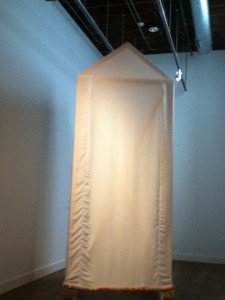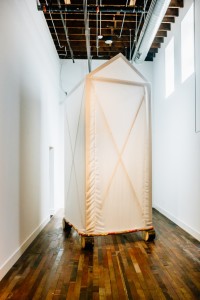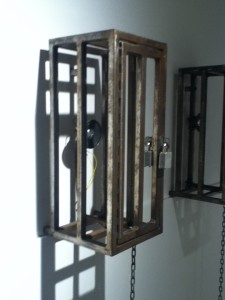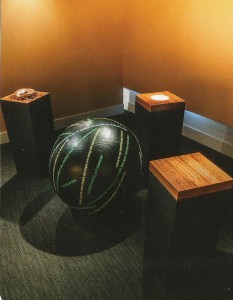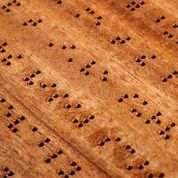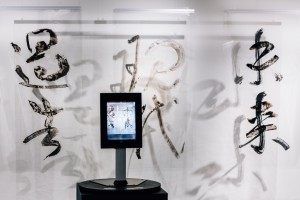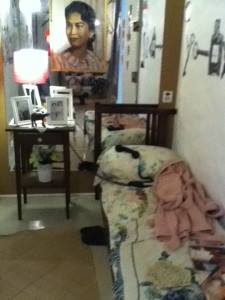QUIET INSIGHTS INTO STRUGGLE AND JOY AWAIT YOU AT THE WING
A tall canvas house looms over us in the first room of “Constructs: Installations by Asian Pacific American Women.”
Lynne Yamamoto’s Whither House honors Japanese-American farmers who could never put down roots. With no windows and doors, the house stands insecurely on log rollers. Up until 1952 “alien land laws” targeted Japanese farmers, preventing them from owning or even leasing land if they were not eligible for citizenship. Many lived in tent houses, tilled land, made it productive and then were forced to move on. And of course, after Pearl Harbor, in the spring of 1942, they were sent to internment camps, where they made even that inhospitable land productive. This simple white tent house that feels so large in the gallery, speaks to that history.
Kaili Chun, Janus, detail, 2010. Steel cells, locks and keys, MP3s, audio speakers. Photo by Toryan Dixon Courtesy of The Wing Luke Museum
We pass into a narrow gallery, on its walls a row of small double locked cages containing a speaker. Kaili Chun‘s installation, Janus, requires us to open the door and to listen. As an Indigenous Hawaiian, Chun deeply feels cultural colonization, both in history and in contemporary agriculture and tourism.
Decontextualized indigenous artifacts from her past survive mainly in museum display cases. As we juggle the two keys and unlock the cage, we listen to the fragments of sounds (or silence), experiencing the disruptions of a trapped culture: waves or birds, or wind, or rain or people singing childlike songs. Some are silent. We feel the oppression as we relock the cages.
Yong Soon Min’s installation LIGHT/AS/IF subtly evokes the elusiveness of memory directly connected to the artist’s own traumatic loss of language and memory from a cerebral hemorrhage. On a wood plank, the artist carved tiny braille letters, quoting from Rumi “The Wound is the Place where the light enters you.” Then, in the artist’s own words, “Invisible wounds are the hardest to heal. They throb with buried memories, telling me that the past is real and that I’ve survived. Of the visible scars, some are unbelievably seductive, as if turning a blind eye to the pain that was the source.”
Braille, which the artist does not read, refers to the way she feels. Loss of sight, like loss of memory, alters our perception of our place in the world, present and past, a frighteningly disorienting experience. Nearby, another wooden plank holds a porcelain bowl of water. As the water slowly evaporates, it marks the passage of time, a metaphor for the slow extended time required for healing. A third piece, a wooden “tree wound” carved by a digital router, also echoes Min’s situation, one step removed from the creation of the work, one step removed from her former reality. A huge ball with texts referring to loss/wounds/healing rolls around in the midst of these subtle pieces, an uncontrolled game with unknown rules, much as life can be for those who lose their memory and the ability to speak.
After Min’s meditative work, Tamiko Thiel and Midori Kono Thiel, mother and daughter artists offer us exhilaration and adventure. Midori Kono Thiel’s Japanese calligraphy becomes abstract art as she writes each stroke of a character on overlapping transparent sheets. Tamiko Thiel, with two engineering degrees, superimposes the calligraphy on an actual place viewed through a tablet or smart phone. In addition to the museum installation, Brush the Sky floats words written in Japanese calligraphy at seventeen locations in Seattle. We can go, for example, to Pike Place Market, the Panama Hotel, the Japanese Garden or the International Fountain, hold up the tablet and read a Japanese phrase that pertains to the site. Each site has personal significance for the artists. At the International Fountain, for example, the calligraphy reads “ Astonishment/Past Present Future.” Their friends Kazuyuki Matsushita and Hideki Shimizu designed the fountain as homage to our efforts to explore outer space at the time of the Seattle World’s Fair. The words float over the site, and “augment it” as we see it on the tablet. A brochure in the gallery includes the Japanese and the translation of each site along with the bar codes.
Terry Acebo Davis, In Her House … Tahanan … Her Room, detail 2015, Bamboo, tyvek, family photographs, wallpaper, found objects, mirrors, bronze, bedroom furniture, banigs (traditional woven mats) Photo by Toryan Dixon Courtesy of The Wing Luke Museum
Almost unbearably intimate, Terry Acebo Davis’s In Her House…Tahanan . . .Her Room honors her mother, as well as the experience of dementia. She asks us to take off our shoes and sit on the bed beside a pink bathrobe and a telephone receiver, suggesting an incomplete connection. A large photograph of her mother as a beautiful young woman hangs above the bed with family photographs on a nightstand nearby. A reversed clock suggests her dementia. As in Yong Soon’s work, we are looking at fragments, references to missing pieces, the sense of the coming apart or the inability to put together, the real. In its place are mementos, photographs, scraps of writing.
Each of these installations invites us to participate: we walk around the house and smell its wood, we open steel cages, we touch the wood carved braille, we wander in the midst of the calligraphy and bring it to public sites, and finally we sit on the bed of an aging mother. We can explore and feel emotions we rarely have the opportunity to experience in an art museum in this subtle exhibition of interactive installations.
While you are in the Museum, you can also visit the “Bojagi: Unwrapping Korean American Identities,” in the downstairs gallery. “Bojagi” is a cloth made “Bojagi” is a cloth made of many pieces. It provides the metaphor for a multimedia and multisensory exhibition, with references to visual art, music, theater, dance, writing, education, and much more.
Finally in the corridor outside, several panels address immigration and deportation, the physical part of the exhibition “Belonging: Before and After the Immigration Act of 1965,” expanded online with a community digital exhibition with visual art and poetry. You can see that without leaving your home.
What you are shortly going to hear about from the Wing is the Bruce Lee exhibition, opening October 4. But before that razzle-dazzle, spend a quiet hour with “Constructs” (which is up until April 17, but don’t wait )and then visit “Bojagi” which closes on November 15.
THE WING LUKE MUSEUM OF THE ASIAN PACIFIC EXPERIENCE
719 S. King St, Tues to Sun, 10am-5pm, (1st Thurs until 8)
This entry was posted on September 24, 2015 and is filed under Art and Activism, Art and Politics Now, art criticism, Contemporary Art, Feminism, Uncategorized.

